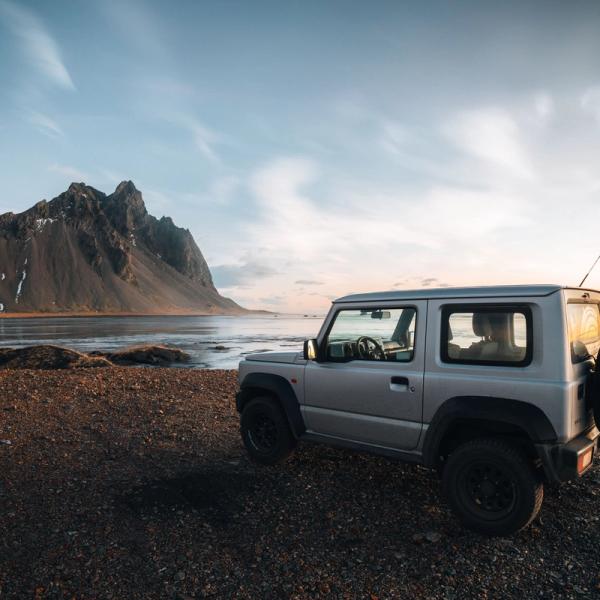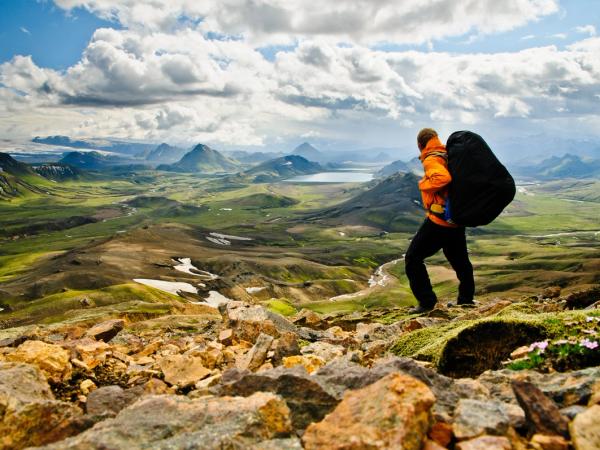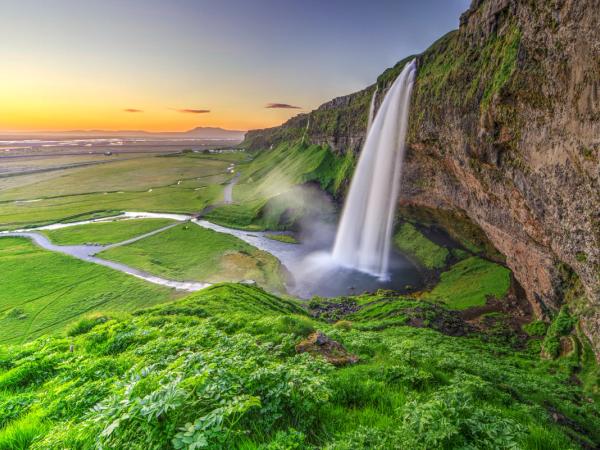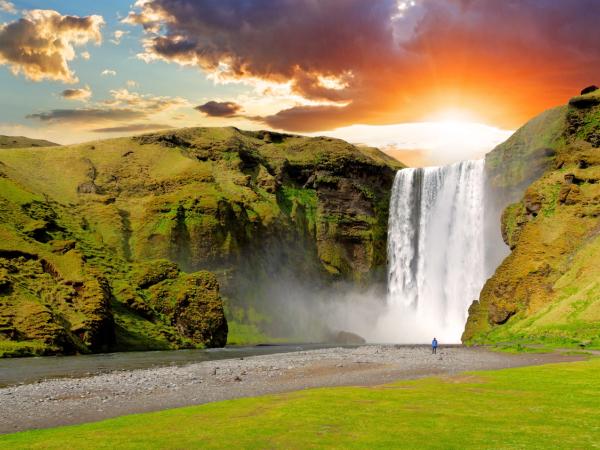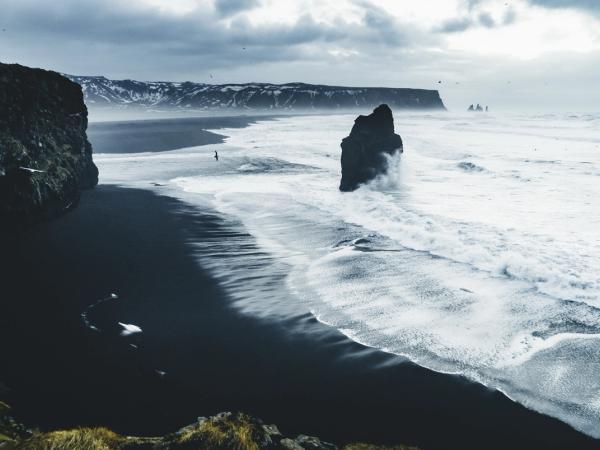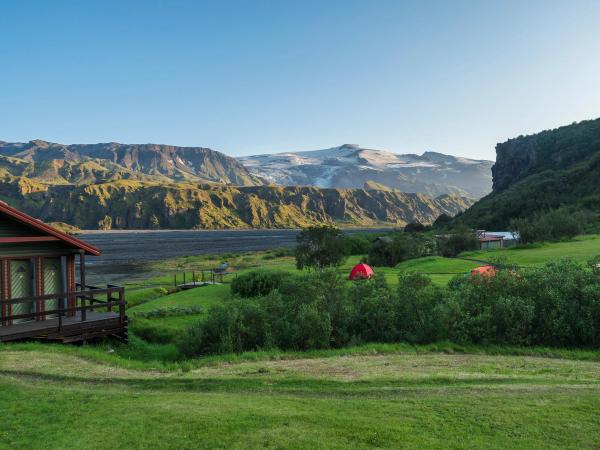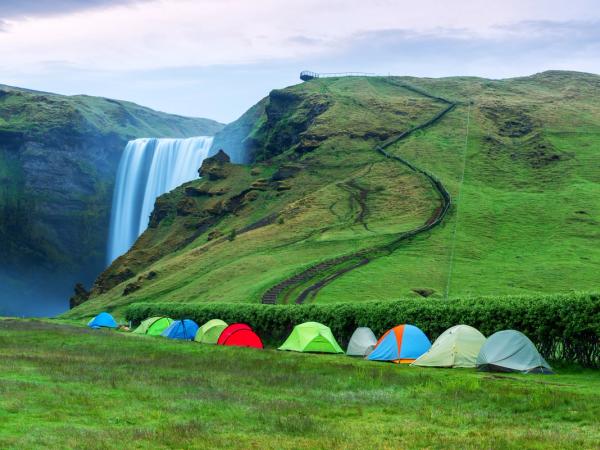
Stakkholtsgjá Canyon: Iceland's Hidden Gem in Þórsmörk
Iceland's landscapes often look like they're from another world, and Stakkholtsgjá Canyon is a perfect example. This moss-covered gorge cuts through Þórsmörk Nature Reserve and feels like walking through a fantasy setting.
With its narrow paths, small waterfalls, and hidden cave, Stakkholtsgjá offers one of Iceland's best short hikes. If you're planning a trip to Iceland's south coast, add this canyon to your list.
Key takeaways:
- Stakkholtsgjá is a 2km-long, 100m-deep canyon in Þórsmörk Nature Reserve
- The moderate hike takes 1-2 hours round-trip and ends at a waterfall
- You need a 4x4 vehicle to reach the area, and it's only open in summer
- The canyon was used in Game of Thrones filming
- You can visit nearby spots like Seljalandsfoss or Valahnúkur Mountain on the same trip
What is Stakkholtsgjá Canyon?
Stakkholtsgjá is a striking slot canyon in Þórsmörk Nature Reserve in southern Iceland. The name might be a tongue-twister (pronounced "Stack-holts-gjau"), but the views are simply amazing.
The canyon is about 2 kilometers long and up to 100 meters deep. What makes it special is the contrast between the dark volcanic rock and the bright green moss that covers the walls. Water flows down the canyon floor, creating small pools and gentle waterfalls along the way.
At the end of the trail, you'll find a hidden waterfall tucked away in the innermost part of the canyon. Although it's not the largest waterfall in Iceland, its secluded setting makes it a special attraction.
Movie fans might recognize Stakkholtsgjá from Game of Thrones. The canyon appeared in Season 7 as the backdrop for the "wight ambush" scene north of the Wall. Even if you haven't seen the show, it's easy to see why filmmakers chose this spot; it has a naturally dramatic look.
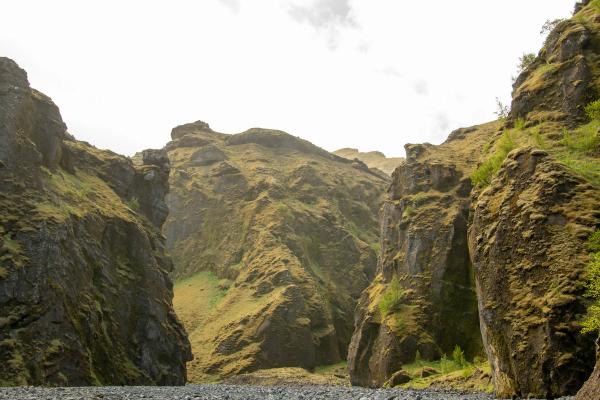
Geology and Formation
The story of Stakkholtsgjá begins with ice and fire, as is often the case in Iceland. The canyon shows how the country's natural forces have shaped the land.
Stakkholtsgjá was formed mainly through glacier erosion during the Ice Age. As massive glaciers moved across the land, they carved channels into the underlying volcanic rock. When these glaciers melted away, rushing water deepened and widened these channels, creating the canyon we see today.
The canyon walls are mostly made of palagonite, a rock formed when volcanic glass mixes with water. This relatively soft material was easily shaped by the forces of glacial erosion. You'll also see impressive basalt formations, including column-shaped basalt in some areas. These six-sided columns formed when lava cooled and contracted, creating geometric patterns that almost look man-made.
The Markarfljót River and its smaller streams continue to shape the canyon today, though much more gently than the glacial floods of the past. The nearby Eyjafjallajökull and Katla volcanoes add another layer to the geological story; ash from eruptions has occasionally affected the canyon's plants and animals. The 2010 Eyjafjallajökull eruption, which halted air travel across Europe, left its mark on the area; however, the canyon has since recovered.
The black sand covering the canyon floor comes from worn-down lava, creating a stark contrast with the green moss that grows in the canyon's damp environment.
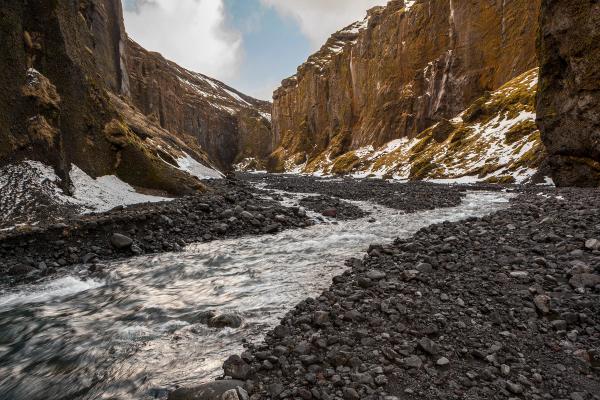
Location and How to Get to Stakkholtsgjá
Stakkholtsgjá Canyon is in the Þórsmörk Nature Reserve in Southern Iceland, nestled between the Eyjafjallajökull, Mýrdalsjökull, and Tindfjallajökull glaciers. It sits north of the famous Eyjafjallajökull volcano and south of the main Þórsmörk area.
Getting to Stakkholtsgjá takes some planning. This isn't a quick stop you can easily visit; it's in the Highlands, and access is limited.
From Reykjavík, take the Ring Road (Route 1) south for about 2 hours until you reach the turn for Route 249 near Seljalandsfoss waterfall. From there, continue onto the F249 mountain road, which leads to Þórsmörk. The "F" in F249 means it’s a mountain road that requires a 4x4 vehicle with high clearance.
This is where things get challenging. The F249 crosses several unbridged glacier-fed rivers, including the sometimes deep Steinholtsá River. These crossings can be dangerous if you don't have experience with river crossings or if water levels are high. Water damage isn't covered by standard rental car insurance in Iceland, so think carefully before trying this drive yourself.
Your options for reaching Stakkholtsgjá include:
- Drive yourself in a proper 4x4 – Only if you have experience with river crossings and rough terrain.
- Take a guided tour – Many companies offer super jeep tours to Þórsmörk that include Stakkholtsgjá. These guides know the safest river crossing spots and can share information about the area.
- Use the highland bus – Companies like Reykjavík Excursions, Trex, and Sterna run buses to Þórsmörk during summer. These modified buses can handle the river crossings and rough roads.
Remember that the highland roads are only open in summer, typically from late May to mid-October, depending on conditions. Always check road.is for the latest information before setting out.
The Hiking Experience
Once you've made it to Þórsmörk, the Stakkholtsgjá trailhead is clearly marked. The hike itself is about 1.5 miles (2.4 km) round trip with a climb of around 410 feet (125 meters). For most hikers in decent shape, it takes between 1-2 hours to finish.
The trail follows the canyon floor, which means you'll walk on black sand and rocks with several small stream crossings along the way. Within 10 minutes of starting, look for Stakkholtshellir, a small cave on the left side of the trail that's worth a quick look.
As you go deeper into the canyon, the walls narrow and the moss-covered cliffs rise higher on both sides. The feeling of entering another world grows with each step. Light moves through the canyon in interesting ways, especially when the sun is high enough to reach the canyon floor.
You'll need to cross the stream several times as you make your way through. During dry periods, these crossings involve simply stepping on rocks. After heavy rain or during spring melt, the water might be higher, requiring more careful steps.
About halfway through the hike, the canyon narrows significantly, creating a slot-like passage that adds to the adventure. The trail isn't technically difficult, but the rocks can be slippery from the constant moisture and moss.
Near the end of the main trail, just before the canyon turns right, look for a narrow slot canyon to the left. This side trip requires crossing the river again but rewards the adventurous with a second, more hidden waterfall.
The main trail ends at the main waterfall at the canyon's end. It's not huge, but the setting makes it special: water falls down a dark rock face surrounded by moss-covered walls. The enclosed space creates perfect acoustics for the sound of falling water.
The return journey follows the same path, giving you a different view of the canyon as you head back toward the entrance.
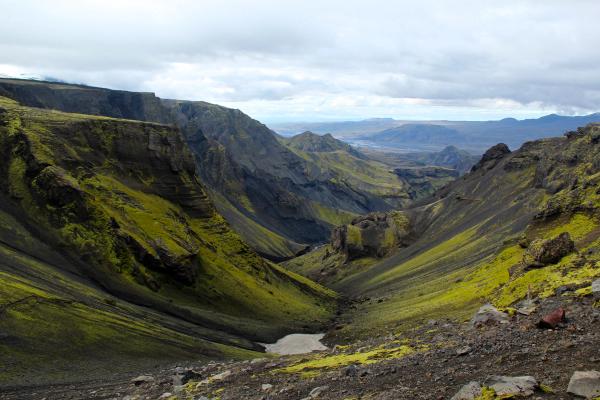
Best Time to Visit
Stakkholtsgjá is a seasonal destination, with access mostly limited to summer months (early June to mid-October). This restriction exists because winter snow and ice make the F-roads impassable, and river crossings become too dangerous.
Even within the summer season, timing affects your experience:
June to August has the warmest temperatures, with averages around 10-14°C (50-57°F). These months also have the longest daylight hours, with the Midnight Sun around the summer solstice giving you plenty of time to explore. The downside is that this is peak tourist season, so trails can be busier, especially in July and August.
September offers a good middle ground: the roads are typically open, fewer people visit, and the landscape looks vibrant. September brings the possibility of early autumn colors to the surrounding birch forests of Þórsmörk.
The best time of day to visit is mid-morning to early afternoon when the light reaches deeper into the canyon. This timing also gives you plenty of daylight hours to handle the drive back if you're not staying in Þórsmörk.
The weather is always a factor in Iceland. Even in summer, conditions can change quickly. Check the forecast before heading out, and be ready for rain at any time. After heavy rainfall, water levels in the canyon's streams rise, making crossings more challenging and potentially dangerous.
For photographers, the light in the canyon changes throughout the day. Morning light tends to be softer and creates fewer harsh shadows within the canyon. The moss appears more vibrant on bright days, but even under cloudy skies, the canyon keeps its mysterious feel.
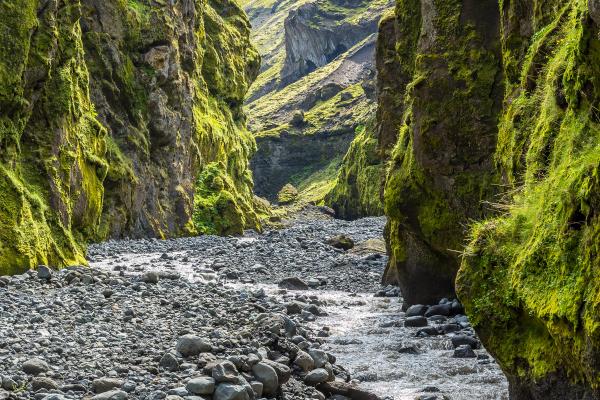
What to Bring and Safety Tips
Good preparation can make a big difference in your experience at Stakkholtsgjá. Here's what you should bring:
Essential Gear:
- Waterproof hiking boots with good grip; regular sneakers aren't suitable here
- Waterproof jacket and pants; Iceland's weather changes quickly
- Layers of clothing, even summer days can be cool
- Hat and gloves, especially early or late in the season
- Small backpack with water and snacks
- Camera (protected from moisture)
- Walking poles, if you use them, are helpful for stream crossings
- Map or offline GPS, as cell coverage is limited in the highlands
During spring or after heavy rain, consider bringing:
- Waders or water shoes for deeper stream crossings
- A dry bag for electronics and spare clothes
- Extra socks; wet feet get cold fast
Safety Considerations:
Stakkholtsgjá is relatively safe compared to some of Iceland's more extreme environments, but there are still risks to be aware of:
- Slippery surfaces – The moss-covered rocks can be very slick, especially when wet. Take your time and test your footing before putting your full weight down.
- Stream crossings – Water levels can rise quickly after rain. If streams look too deep or fast-moving, turn back. No waterfall view is worth risking your safety.
- Weather changes – Iceland's weather can change rapidly. Bring layers and rain gear, even if the forecast looks good.
- Isolation – While Þórsmörk isn't remote by Icelandic standards, you'll be away from immediate help. Let someone know your plans before hiking.
- Leave no trace – The delicate moss ecosystem takes decades to recover from damage. Stay on the trail and never take shortcuts that damage vegetation.
If you're visiting in early or late season, check with local rangers or tour operators about conditions. Sometimes the trail is technically open, but stream crossings might be dangerous due to spring melt or autumn rains.
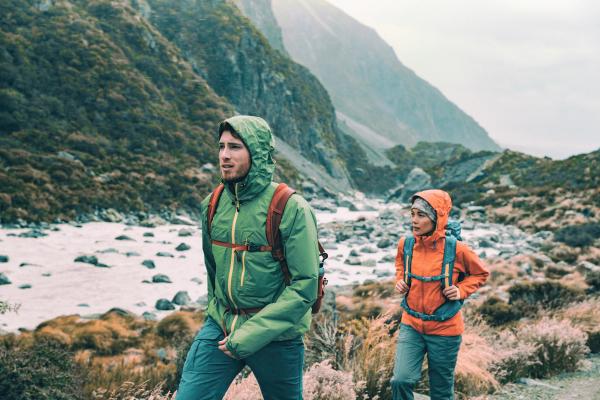
Nearby Attractions
Stakkholtsgjá is just one highlight in an area full of natural wonders. Consider combining your visit with these nearby attractions:
Within Þórsmörk:
- Valahnúkur Mountain – A relatively short but steep hike offering panoramic views of the entire Þórsmörk area, including glaciers and river valleys. It's only a 10-15-minute drive from the Stakkholtsgjá trailhead and takes 2-3 hours to hike.
- Laugavegur Trail – Þórsmörk marks the southern end of this famous multi-day trek. If you're not up for the full hike, you can try a section near Þórsmörk for a taste of the experience.
- Básar – This area of Þórsmörk offers several day hikes with stunning views of Eyjafjallajökull glacier.
En Route to Þórsmörk:
- Seljalandsfoss – This 60-meter waterfall is right off the Ring Road on your way to Þórsmörk. What makes it special is the path that lets you walk behind the cascade. It's approximately 30 km from Þórsmörk, or a 30-40 minute drive by car.
- Gljúfrabúi – Often missed by tourists rushing to Seljalandsfoss, this "hidden" waterfall is just a short walk away. It's partially hidden within a rock face, requiring a wade through a narrow gorge to see it properly.
- Nauthúsagil Canyon – Near the F249 turnoff, this narrow canyon offers a short but adventurous hike to a small waterfall. It's less known but offers a nice contrast to Stakkholtsgjá's wider space.
Worth a Detour:
- Skógafoss – One of Iceland's most famous waterfalls, located about 30 km from the turn to Þórsmörk (25 minutes by car). The 60-meter cascade creates frequent rainbows on sunny days, and you can climb 527 steps for a view from above.
- Kvernufoss – A hidden gem near Skógafoss, accessible via a short hike from the Skogar Museum parking lot. Like Seljalandsfoss, you can walk behind this waterfall.
- Reynisfjara Beach and Vík – About 60 km from the turn to Route 249 (45 minutes by car), this black sand beach features dramatic basalt columns and sea stacks. The nearby village of Vík offers services and accommodation.
If you have time for a multi-day trip, consider hiking the Fimmvörðuháls trail from Skógar to Þórsmörk. This challenging 25 km trail crosses between the Eyjafjallajökull and Mýrdalsjökull glaciers, offering views of recent lava fields from the 2010 eruption.
Where to Stay
If you want to fully experience Stakkholtsgjá and Þórsmörk without rushing, staying overnight in the area makes sense. Your options include:
Within Þórsmörk:
- Þórsmörk Volcano Huts – Located at Húsadalur, these offer various accommodations from dormitory beds to private cabins. They have a restaurant, showers, and kitchen facilities. Prices start around 10,000 ISK ($70) for dorm beds and 30,000 ISK ($215) for private rooms.
- Básar Hut – Run by the Icelandic Touring Association, this mountain hut offers dormitory-style accommodation and camping. It's simpler than the Volcano Huts but more affordable. Dormitory beds cost around 8,500 ISK ($60) per night.
- Camping – Both Húsadalur and Básar have designated camping areas with basic facilities. Camping fees are around 2,500 ISK ($18) per person per night.
Nearby Options:
- Hvolsvöllur – This town, about an hour from Þórsmörk (when road conditions are good), offers several hotels and guesthouses. It makes a good base if you prefer more comfort but still want relatively easy access to Þórsmörk.
- Skógar – Located near Skógafoss waterfall, Skógar has a few accommodation options about 45 minutes from Þórsmörk.
- Hella – Slightly further away, Hella offers more accommodation choices and services.
If you’re staying in Þórsmörk, book well in advance, especially for July and August. The huts fill up quickly, particularly around weekends.
For camping, bring a sturdy tent that can handle wind, as Iceland's weather is unpredictable even in summer. Wild camping is completely forbidden in Iceland, which means you must stick to designated camping areas.
All accommodations in Þórsmörk are relatively basic; this is a nature reserve, not a resort area. Expect limited (or no) cell service and Wi-Fi. Power may be restricted to certain hours for charging devices. Pack accordingly, bringing portable chargers and downloads of any essential information.
Final Thoughts
Stakkholtsgjá Canyon offers a perfect slice of Iceland's wild beauty, requiring neither technical hiking skills nor multi-day commitments. The reward-to-effort ratio is high; in just a couple of hours, you can experience one of Iceland's most atmospheric landscapes.
What makes Stakkholtsgjá special isn't its size or statistics, but the feeling of discovery as you venture deeper into the canyon. Each bend reveals new views, and the final waterfall feels like a secret you've earned by making the journey.

